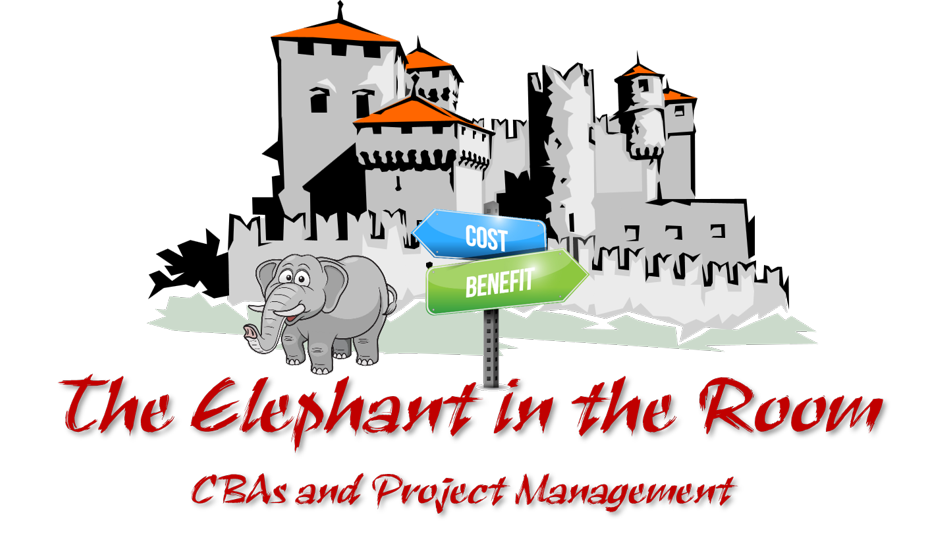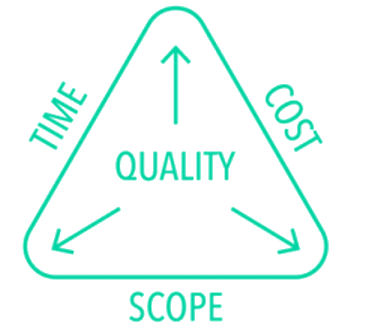
By Michael A. Velez, Managing Director of Castellan Systems
Let me start by giving a little background of myself. I’ve been in IT for over 40 years; I started managing projects in the mid-1980s and have worked for some very large organisations in that time like BHP Steel, BHP Information Technology, CSC Australia (today DXC Technology), ING Australia (today OnePath) and Pillar Administration (today Mercer Administration Services).
I’ve read a lot about “Cost Benefit Analysis (CBA) in Project Management”, Castellan Systems even provides a tool, as an addon to our core Project Management solutions to prepare a CBA. So let’s start by putting the elephant in the room:
I don’t believe that generating a CBA is a project management function and that a project manager should not touch a CBA not even with a “ten-foot pole!”
There it is, I said it. I don’t mean performing a cost benefit analysis to make a decision within a project; that tends to be less formal, contained within the project team and the benefits are only to the project. I’m talking about cost benefit analysis to determine whether an initiative is worth pursuing.
Let me say that it was only while working in the latter of those organisations that I mentioned, in my last 5 years working for other people, that I had to prepare that type of CBAs. It wasn’t that the projects I managed in the other organisations weren’t evaluated through a cost benefit analysis, it was simply that it wasn’t up to me to do it.
But for now, let’s leave the elephant in the room for a moment and look at a couple of things.
What is a CBA?
|
Cost Benefit Analysis, or CBA within project execution is the process of comparing the projected or estimated costs and benefits (or opportunities) associated with a project or decision to determine whether it makes sense from a business perspective. Generally speaking, cost-benefit analysis involves tallying up all costs of a project or decision and subtracting that amount from the total projected benefits of the project or decision. (Sometimes, this value is represented as a ratio.) If the projected benefits outweigh the costs, you could argue that the decision is a good one to make. If, on the other hand, the costs outweigh the benefits, then a company may want to rethink the decision or project. Cost-benefit analysis is a form of data-driven decision-making most often utilised in business, both at established companies and start-ups. The basic principles and framework can be applied to virtually any decision-making process, whether business-related or otherwise. |

|
What is Project Management?

|
A project is a temporary endeavour designed to produce a unique product, service or result with a defined beginning and end (usually time-constrained, and often constrained by funding or staffing) undertaken to meet unique goals and objectives, typically to bring about beneficial change or added value. Project management is the practice of initiating, planning, executing, controlling, and closing the work of a team to achieve specific goals and meet specific success criteria at the specified time. There are three constraints or dimensions faced in every project: Scope, Time, and Cost. They are a part of every project and though they can be limiting, when properly managed they should not affect a successful project outcome. These are often characterised in the Project Management Triangle, shown on the left. So, a project is about delivering a Scope (What), within in a Timeframe or Schedule (When) for a specified Cost (How Much) to a required level of Quality. Let’s not confuse “initiating” with “cost benefit analysis”; the former is about starting a project that has been approved to proceed and the latter is about determining whether it should be approved to proceed or not. |
Preparing a CBA
A CBA is produced when an idea or initiative is identified; it’s usually prepared when there is sufficient knowledge of the requirements of the initiative so that the costs of delivering these requirements can be prepared. Obviously, these costs can only be indicative; other terms that I’ve come across for this cost estimate is “budget estimate” or “rough order of magnitude (or ROM)”.
What is this CBA used for? It’s used to determine whether it’s worthwhile proceeding with a project to deliver the initiative.
The process for preparing a CBA is as follows:
-
Tally costs: You’ll likely begin with direct costs, which include expenses directly related to the production or development of a product or service (or the implementation of a project or business decision). Labour costs, manufacturing costs, materials costs, and inventory costs are all examples of direct costs.
But it’s also important to go beyond the obvious. Other cost categories you must account for include:
- Indirect Costs: These are typically fixed expenses, such as utilities and rent, that contribute to the overhead of conducting business.
- Intangible Costs: These are any costs that are difficult to measure and quantify. Examples may include decreases in productivity levels while a new business process is rolled out, or reduced customer satisfaction after a change in customer service processes that leads to fewer repeat buys.
- Opportunity Costs: This refers to lost benefits, or opportunities, that arise when a business pursues one product or strategy over another.
-
Similarly, benefits can be:
- Direct: For example, increased revenue and sales generated from a new product.
- Indirect: Such as increased customer interest in your business or brand.
- Intangible: For example, improved employee morale.
- Competitive: For example, being a first-mover within an industry or vertical.
In my experience, benefits are tallied over a period of time; usually 5 years but I’ve seen it done over a 10 year period.
For both costs and benefits, a monetary figure is usually assigned, although there may be benefits where that’s impossible.
So once the CBA is produced, if the monetary value of the benefits is greater than the monetary value of the costs, then proceeding with a project is appropriate. This value may also be represented as a ratio.
The Elephant
So, let’s get back to that elephant I left in the room.
The CBA is an input into the business case and we can all agree that the business case is prepared by the people in the business that have a vested interest in implementing the initiative. I’ve seen project managers appointed to oversee this, but it’s been more a coordination than authoring function. Generally it’s the owner or identifier of the initiative who has to justify the expenditure.
So if the CBA is prepared in order to determine whether proceeding with a project is an appropriate decision, is it a project management process? Is the project manager the appropriate person to prepare it?
As far as I’m concerned, the answer is “no” in both instances. OK, why?
If a project has not been initiated, any processes being performed can’t be project management; there is no project to manage! If there is no project, there is no project manager and therefore they are not around to prepare this CBA!
Simple? Well yes but it’s usually a little more complex than that. I, while working as a project manager, have had to prepare CBAs. But was I acting as a project manager while doing this? No.
A project manager assigned to an initiative before a project is approved is not performing project management processes but bid management or sales processes. A project manager can only produce the costs of delivering the identified requirements; they are not in a position to identify the benefits, let along, quantify them. The only people that can identify and quantify the benefits are the business staff, in particular the person who came up with the idea in the first place.
Does the project manager care whether the project will deliver a benefit to the business? Simple answer, no. The project manager will manage any project that they have been assigned to do and stride to deliver it as per the contract. Once they’ve completed the project, they move to another and don’t really stick around to see the benefits being realised.
Then, if the project manager doesn’t care whether the project will deliver a benefit to the business, who does? The business team(s) who’ll should be benefiting from the delivered requirements and specifically, the person who came up with the idea. They are the champion of the initiative/project; they are the ones that need to justify to their management the benefit of such an expense. They are the ones that will, effectively, pay the bills for the project execution.
OK, that may be a little confusing, so let’s put it in some simpler terms. We all use cost benefit analysis in our everyday lives; we just don’t realise we’re doing it. Every time we make a purchase, especially a significant one, we do a CBA of sorts in our heads; some may actually put something on paper. The perfect example is buying a house; we usually have several options for which we may prepare a CBA of some sort to help up make a decision:
There may be others, but these are the main 3 options. Let’s say we’ve chosen to build a new property (either option 2 or 3); we find a builder and get them to give us an estimate to build. In this scenario we are going to want a fairly accurate estimate. So what’s our role in the above part of the scenario? We’re the customer and the person that came up with the idea. So what’s the builder’s role in the above part of the scenario? They are service delivery and are effectively performing a bid management or sales role. Not a project management role? Well no because no work, or project, has been approved. |

|
Now that we have this estimate, what do we do with it? We do 2 things:
-
We evaluate as to whether it’s a cost effective solution for us; in order words, it gives us a positive cost benefit analysis.
Why don’t we expect the builder to do this CBA process if they are service delivery and will be project managing the build? Because it doesn’t make sense for the builder to do this.
-
We come up with the money to pay for the project. It may involve us going to the bank and asking for a home loan. The bank may do their own cost benefit
analysis that will involve our ability to pay the loan back and what profit, i.e. interest, will there be in it for them.
We, as the people who will benefit from the delivered build, need to justify the expenditure to whoever is providing the funds for the build; not the builder.
I think that we will all agree that once we give the builder the go ahead, they’ll appoint a project manager (they may use a different title) who will then be responsible for executing the build. Even in a situation where we’re the owner/builder, when we’re doing those 2 tasks above, we’re playing our owner role and not our builder role.
But the builder, neither in the initial engagement or during the build, gets involved in determining as to whether building this property in this location is a worthwhile thing to do; they don’t need to come up with the money to pay for it; they don’t need to justify the expenditure. To them it’s just work for which you are going to pay them and they’ve built a profit into the pricing that they gave you.
Let’s Review
OK, you may be saying to yourselves now, “I see the point that you’re making, but a CBA may also be prepared after the project has been initiated or the existing one updated and re-reviewed.”
Yes, I know but this usually occurs when the requirements have been refined and the scope of the solution that needs to be delivered becomes clearer. You want to ensure that it still makes sense proceeding before more expenditure is incurred. But once again the project manager can only produce the costs of delivery the identified requirements; they are not in a position to identify the benefits, let along, quantify them. The only people that can identify and quantify the benefits and needs to justify the expenditure is the person who came up with the idea in the first place.
As I said, I started managing projects in the mid-1980s and have worked for some very large organisations. As I’ve also indicated in was only at Pillar Administration, in my last 5 years working for other people, that I had to prepare CBAs. It wasn’t that the projects I managed previously weren’t evaluated through a cost benefit analysis, it was simply that it wasn’t up to me to do it. Who did it? The customer that requested the project, whether they were external or internal to the organisation.
Why did I do it at Pillar Administration? I actually still don’t understand why. We even did CBAs for projects initiated and paid by external customers. Were we ever going to say to a customer, “sorry but we won’t proceed with this project because you won’t get a return on your investment based on our CBA.”? Of course not.
For such projects, all we should had been doing was a pricing review, which is what I did at the other organisations:
- Has all the work required been identified?
- How accurate is the estimated costs?
- Have the appropriate resource cost rates been selected? This could be based on the skills of the resources required, or the people that are actually available to work on this project.
- Based on the selected costs rates, have the appropriate sell rates been selected?
- Have risks been analysed and an appropriate level of contingency been added?
- Is this pricing offered as a Time & Materials (T&M) or Fixed Price (FP) proposal? This is important because you tend to carry a larger contingency for FP proposals than T&M. In FP proposals, you carry all of the risk; for T&M, the customer carries a significant part if not all of the risk.
If all of the above is done correctly, that the benefit to my organisation is the margin between what we’re going to charge the customer and what it’s going to cost us. Only when this difference is negative should be consider turning down the project. Although there may be other, strategic, considerations as to why you may proceed even in these cases, e.g. you’re trying to get your foot in the door with this customer and desire more work from them.
But even for internal projects, the project manager and their team don’t have the knowledge to identify and quantify the benefits. Once again, this is the role of the person who came up with the idea, the person that has to convince management to spend the money, the person who would then be responsible for realising the benefits once the project has been delivered.
The only reason I can see why I prepared CBAs at Pillar Administration was that I already had the project costs and understood what the aim of the exercise was. I still had to get the business teams, for internal projects, to identify and quantify the benefits; then I was just their typing assistant and entered them in the template. For external projects, we really, generally, didn’t bother identifying benefits but we still prepared a CBA and reviewed it; in most instances we were doing a pricing review and calling it a CBA review.
Let’s look at an actual example. Soon after I started as a permanent employee at Pillar, I was given a project that had been approved by the customer before I started. As per the normal process, we completed the requirements phase and produced a Business Requirements Document or BRD; the project involved modifying the admin systems to provide a new financial product for their clients. We costed the effort to deliver these requirements and completed our CBA. Of course for Pillar it was a go as they were going to make money from the execution of the project; they would have made more money from the administration of the new financial product. But the customer could not justify proceeding with the project; the costs of it were greater that their earnings from the potential uptake of this new product. So the project was cancelled.
Performing a cost benefit analysis only makes sense if you’re the one spending the money. Do you think that a retail shop (service delivery) does a CBA before they sell you something? Of course not; their profit and, therefore, their validation for the sale is built into the price that they are charging you. It recovers their costs and includes their margin (of which a profit is part or all of it).
But in defence of Pillar Administration, the solutions delivered by these projects were usually operated by Pillar staff as they also provided superannuation administration services to their customers and the systems being changed, enhanced or newly developed were in most part going to be operated by Pillar staff. The projects could lead to more or less work for Pillar admin staff, this could be quantified as negative or positive benefits. But since the customer paid for these admin services, was a “negative” benefit really a bad thing? Wouldn’t the customer pay for this additional effort and Pillar make more money? Although for a “positive” benefit, they could decide that less staff could perform the same tasks and some resource(s) could be reassigned or eliminated altogether leading to more savings. But still would we tell the customer that we wouldn’t be proceeding because it didn’t make much sense to us? They are paying the bills; it’s their business case that needs to stand-up to scrutiny.
In Conclusion
A CBA is prepared by the people that identify the initiative, have a vested interest in what it will deliver and have to pay the bill(s) for any project(s) approved. And that person is never the Project Manager. Also, it has nothing to do with managing the project(s) as a project will deliver the same “solution” whether it was a worthwhile expenditure or not.
So tell us old wise one, if it’s not a Project Management process than what is it? It’s Change Management process; Enterprise Change Management that is, not Project Change Management.
This article was written by Michael A. Velez, Castellan Systems’ Managing Director, who has over 40 years’ experience in the IT industry working for several large, multi-national corporations. He has worked as project, programme and portfolio manager.

